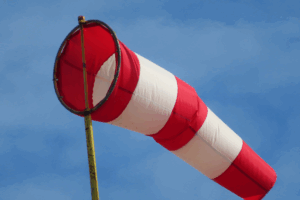When commercial airports started operating in the early 1900s, runway lighting systems often consisted of kerosene flares, beacon fires, and floodlights to mark the landing area. Back then, airport operators used whatever was handy to ensure the safe and efficient takeoff and landing of aircraft.
Fast forward to today’s modern airports, where advanced technology has become indispensable in everyday runway lighting systems. One key example of an innovation that pilots have come to rely on during approach is the Precision Approach Path Indicator (PAPI).
The units are so effective at improving airport runway safety that the Federal Aviation Administration (FAA) and the International Civil Aviation Organization (ICAO) both mandate the use of PAPI systems at most commercial airports
In this month’s blog, we uncover what PAPI units do, how they work, and why your airport needs to have operational PAPI units in place.
How Precision Approach Path Indicator Systems Work
A PAPI unit is a series of light fixtures installed beside the runway. Larger airports typically use four light head units lined up in a single row, whereas some smaller airfields use as few as two light heads.
Each PAPI fixture emits a beam divided into two color zones: white on top and red on the bottom. Pilots see a mix of these colors that indicate their current angle of approach:
- More white lights than red appearing indicates an approach that’s too high
- More red lights than white appearing indicates an approach that’s too low
- Two white lights and two red lights indicate the correct glide approach

It’s a straightforward system that provides an immediate visual cue for pilots. Unlike cockpit instruments that require time to interpret, PAPIs provide direct confirmation of a plane’s descent altitude, allowing for real-time corrections at critical moments.
What Are The Benefits Of Installing Precision Approach Path Indicators At Airports?
Approach and landing are among the most challenging phases of flight, particularly during inclement weather, periods of low visibility, or when runways are surrounded by obstacles. PAPI units help mitigate the risk of accidents by:
- Helping pilots avoid undershooting or overshooting the runway threshold
- Providing consistent visual confirmation, even when cockpit instruments fail or signals are disrupted
- Preventing controlled flight into terrain (CFIT) by keeping the aircraft aligned with the safe glide slope
- Allowing pilots to get instant path verification at a glance instead of having to cross-check multiple instruments, enabling them to pay more attention to other critical tasks, such as monitoring airspeed, crosswinds, or traffic separation
Although they provide significant safety advantages to airports, PAPIs also offer other crucial benefits that enhance operations:
- Enables precise landings in variable weather and visibility conditions, increasing the effective capacity of the runway
- Reduces the frequency of go-arounds and aborted landings, keeping operations on schedule
- Helps mitigate the risks of accidents caused by approach errors that lead to lengthy investigation and litigation processes
- Enhances an airport’s reputation for regulatory compliance and proactive safety investment when PAPI systems are properly installed and maintained
- Uses LED technology that consume less energy, minimize runway downtime for maintenance crews, and require fewer bulb changes than their halogen predecessors, delivering significant cost savings to airport operators
- Easily integrates with Advanced Lighting Control and Monitoring Systems (ALCMS), which gives operators centralized visibility and control, including the ability to automatically adjust PAPI beam brightness according to visibility conditions
Read More: 5 Essential Takeaways When Upgrading Your Runway Lighting System
Increase Airport Safety With The L-880(L)/L-881(L) LED Precision Approach Path Indicator Lighting (PAPI)
When you’re looking to upgrade or expand your runway system with a high-quality PAPI that uses LED technology, the L-880(L)/L-881(L) unit offers the perfect solution.
This PAPI system provides reliable photometric performance using LED bulbs that provide more than 150,000 hours of service. The units are compact and lightweight, and feature a digital LED display that indicates status without the need to open them. They’re also quick and easy to maintain, requiring no optical bench or special tools for servicing.
The L-880(L)/L-881(L) unit sets the standard for advanced runway safety, efficiency, and cost-effectiveness, delivering the precision, durability, and reliability that airports need to protect pilots, passengers, and airport infrastructure.
If you have any questions about why your airport should invest in PAPI technology, contact the experts at Airport Lighting Company for fast, friendly service. We’re always happy to connect our customers with customized solutions that enhance the safety, efficiency, and profitability of their operations.
Call Airport Lighting Company For The Latest In Airport Lighting Technology
The Airport Lighting Company team is standing by to answer your questions about how our tech-based products can help improve the safety, reliability, and efficiency of your runways. Call 315-682-6460 for fast, friendly service you can count on.


